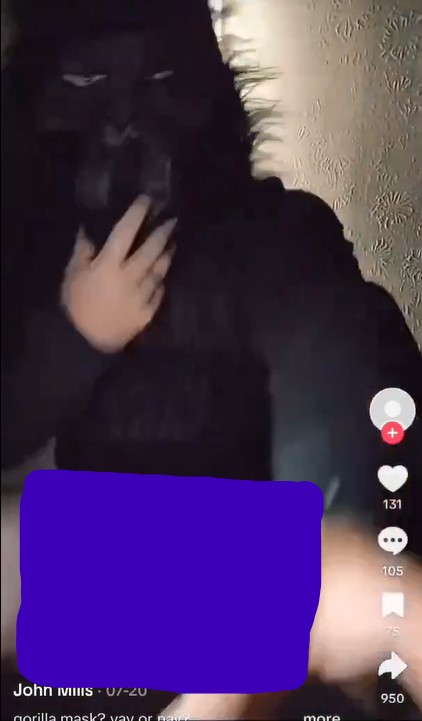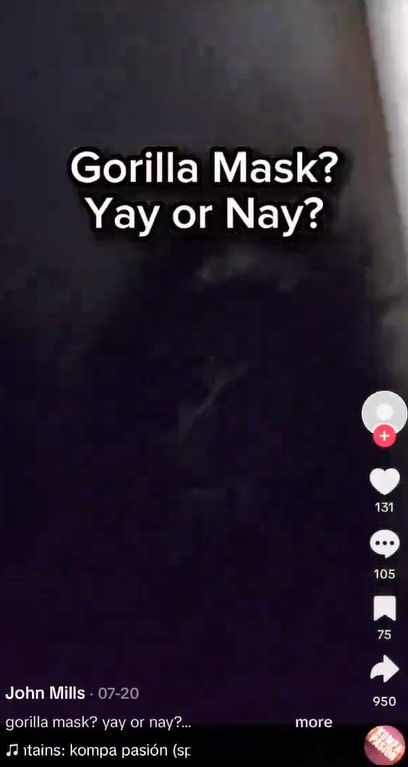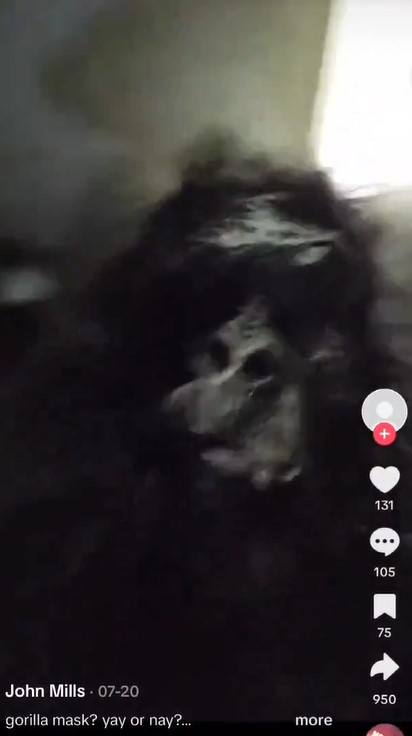Gorilla Mask Video and Exploring the Controversy Behind
In recent years, TikTok has become a playground for various trends and memes, some of which push the boundaries of creativity and others that border on violating community standards. One such controversial trend is “secret flashing,” where creators attempt to bypass the platform’s strict content policies by covertly exposing themselves, as exemplified by the gorilla mask video. This practice not only challenges the effectiveness of TikTok’s content moderation but also raises significant ethical concerns about consent and online behavior.
One of the more blatant instances of this trend involved a video featuring a man wearing a gorilla mask. This video, which has since been removed from the platform, showcased the individual initially presenting the mask to the camera with a seemingly innocent poll asking viewers, “Gorilla Mask? Yay or Nay?” As the video progresses, it takes a disturbing turn. The man, positioned in what appears to be a semi-public space like a hallway or a basement of a large building, casually “drops” his phone. As the phone hits the ground, the camera angle reveals that he is naked from the waist down. This act was clearly designed to skirt the edge of TikTok’s community guidelines by embedding the inappropriate content in what starts as a harmless mask review.
The video ended as quickly as it escalated, with the masked individual picking up the phone, apologizing for the drop with a text overlay, and giving a final close-up of the mask. Despite the swift removal of the video from TikTok, it highlights a growing problem on social media platforms where users exploit loopholes in content policies to engage in problematic behaviors, sparking a wider debate about digital responsibility and the mechanisms necessary to protect community standards.
| Element | Content Description |
|---|---|
| TikTok Trend | “Secret flashing” involving covert exposure to bypass platform content policies. |
| Example | Gorilla mask video where a man reveals he is naked from the waist down. |
| Context | Video features a mask poll, escalates to inappropriate content, quickly removed. |
| Issues | Challenges TikTok’s moderation, raises ethical concerns about consent. |
| Implications | Highlights exploitation of policy loopholes, sparking debate on digital responsibility. |
The Incident and Video
The video in question opened with the user @john.mills984, who is now no longer active on TikTok, showcasing a gorilla mask to his audience. The setting appeared to be a semi-public space, possibly a hallway or a basement within a large building, hinting at a casual, impromptu recording session. The video was framed as a playful engagement with viewers, starting with a text overlay asking, “Gorilla Mask? Yay or Nay?” This seemingly innocuous beginning, however, was a setup for the shocking content that would follow.
Gorilla mask video leaves everyone astonished
As the video progressed, the creator’s intent became clear. Approximately halfway through, he executed a maneuver where he ostensibly ‘dropped’ his phone. As the phone descended, the camera blurred momentarily before landing in a position that revealed the man was naked from the waist down. This revelation was both sudden and unexpected, serving as the crux of the ‘secret flashing’ act. The camera’s new angle captured the man standing above the device, exposed, before he calmly reached down to retrieve the phone.
Uncensored gorilla mask video
The video concluded with the man picking up his phone and displaying a text overlay that read, “Sorry… dropped my Phone.” He then shifted the focus back to the gorilla mask, holding it up to his face and securing it with one hand, as if to remind viewers of the initial premise of the video. The abrupt shift from a quirky mask review to inappropriate exposure was jarring and highlighted the deceptive nature of the content.
| Aspect | Description |
|---|---|
| Opening Scene | User @john.mills984 introduces a gorilla mask in a semi-public space, starting with a playful poll. |
| Setting | Possibly a hallway or basement, casual and impromptu recording session. |
| Progression | Video progresses to reveal the creator’s intent, with a phone drop maneuver revealing nudity. |
| Climax | Camera captures the man naked from the waist down as he picks up the phone. |
| Conclusion | Man apologizes for the drop, refocuses on the gorilla mask, masking the initial playful setup. |
TikTok’s Response
Following the posting of the video, TikTok quickly took action by removing it from the platform. This response was in line with the platform’s strict community guidelines, which prohibit nudity and sexual content. TikTok’s community guidelines are explicit in their prohibition of content that includes adult nudity or activities that are sexually provocative, especially content that could be unexpectedly viewed by users who do not consent to such material.
The removal of @john.mills984’s account underscores TikTok’s commitment to enforcing these rules, particularly against content that cleverly attempts to bypass their detection systems through tactics like ‘secret flashing.’ The platform has faced criticism in the past for not acting swiftly enough to curb harmful trends, but in this instance, their response was both rapid and decisive.
This incident opens up broader discussions about the challenges social media platforms face in moderating content that creatively violates guidelines. While TikTok and similar platforms have developed sophisticated algorithms and employed extensive moderation teams to combat inappropriate content, the evolving nature of user-generated videos means that new methods of guideline evasion are always emerging. The gorilla mask video exemplifies how users might exploit the spontaneity of video drops and the ambiguity of visual content to skirt around established content policies.
Moreover, the incident raises significant questions about the responsibilities of social media platforms to adapt and respond to new forms of content violation. It also highlights the ongoing need for platforms to balance the promotion of creative expression with the enforcement of community standards to ensure a safe and respectful online environment. As users continue to find inventive ways to challenge these boundaries, the pressure on platforms like TikTok to innovate in their content moderation strategies will undoubtedly increase.
| Action Taken | Community Guidelines | Platform’s Commitment | Challenges in Moderation | Broader Implications |
|---|---|---|---|---|
| Video and @john.mills984’s account quickly removed from TikTok. | Prohibits nudity and sexually provocative content without consent. | Enforcement against ‘secret flashing’ shows strong commitment to guidelines. | New methods of evasion are constantly emerging, challenging content moderation. | Incident raises questions about balancing creative expression with community standards. |
User Reactions and Impact
The reaction to the gorilla mask video on social media was swift and overwhelmingly negative. Many users expressed shock and dismay at the blatant disregard for community standards and the non-consensual nature of the content. Discussions proliferated across various platforms, not only criticizing the specific video but also questioning TikTok’s ability to control similar content. Concerns about the potential normalization of such behavior, especially among impressionable younger audiences who form a significant portion of TikTok’s user base, were prominently voiced.
In the aftermath, several TikTok accounts began impersonating the banned user @john.mills894, further complicating the platform’s efforts to manage the fallout. These accounts often engaged in trolling by posting ambiguous content, sometimes mimicking the original video’s style, which muddied public understanding and response. One notable impersonator posted a video featuring a close-up of their hand with a background sound that taunted, “come and get it,” playing into the controversy and provoking further public outcry.
| Public Reaction | Discussion Topics | Impersonation Issues | Impersonator Tactics |
|---|---|---|---|
| Swift and overwhelmingly negative reaction on social media. | Criticisms of the video and questions about TikTok’s control over similar content. | Impersonation of banned user @john.mills894 complicating management of the situation. | Impersonators posted ambiguous content, sometimes mimicking the original, provoking public outcry. |
Broader Context
The incident is part of a disturbingly growing trend of ‘secret flashing’ videos on TikTok, where users exploit the video format to include sudden, unexpected reveals that violate the platform’s guidelines. Another notable incident by the same user involved a video shot from a first-person perspective walking through a Walmart, ostensibly to buy sheets. The video ended with a quick flash of nudity, followed by a pan back up, and a text overlay jokingly asking, “Which Sheets Should I Get??” This video, too, featured the username @john.mills894, linking it directly to the individual behind the gorilla mask incident.
These ‘secret flashing’ videos are gaining popularity for several reasons. Firstly, the shock value and the element of surprise tend to generate significant engagement in the form of views, likes, and shares, rewarding creators with a perverse form of social media currency. Secondly, the challenge of evading content moderation algorithms itself can become a game, with creators pushing the boundaries to see how much they can get away with. Finally, the viral nature of such content, driven by both outrage and curiosity, creates a self-perpetuating cycle that encourages imitators.
The ethical and legal implications of such videos are severe. Ethically, these videos breach the basic social contract of respecting others’ boundaries and consent. The non-consensual nature of ‘secret flashing’ makes it not just a violation of social media guidelines but a broader social misdemeanor. Legally, depending on the jurisdiction, such actions can qualify as indecent exposure or sexual harassment, carrying potential legal penalties. Moreover, the presence of minors on platforms like TikTok adds another layer of legal complexity, as exposing minors to such content can invoke stringent child protection laws.
The broader context of this trend reflects a worrying shift in digital content interactions, where the line between online antics and real-world consequences becomes increasingly blurred. As platforms like TikTok continue to grow, the need for more robust content moderation strategies becomes imperative. This includes not only technological solutions like better detection algorithms but also comprehensive educational efforts to foster a healthier online culture that respects personal boundaries and promotes safe digital spaces. The conversation sparked by incidents like the gorilla mask video is crucial as it highlights the ongoing challenges and responsibilities faced by both users and platforms in navigating the complex digital landscape.
| Trend Description | Popularity Reasons | Ethical and Legal Implications | Broader Context |
|---|---|---|---|
| Growing trend of ‘secret flashing’ videos on TikTok, including unexpected nudity that violates guidelines. | Shock value and surprise generate engagement; evading moderation seen as a challenge; viral nature encourages imitators. | Violates consent and social boundaries; potentially classified as indecent exposure or sexual harassment; complex legal issues with minors. | Reflects a worrying shift in digital content interactions, necessitating robust moderation and educational efforts to foster safe online culture. |
The “gorilla mask” incident on TikTok, involving a user who exploited the platform’s video format to engage in ‘secret flashing,’ underscores a troubling trend that poses significant ethical and safety challenges in the digital space. This episode, part of a broader pattern of similar incidents, has catalyzed discussions about the adequacy of current content moderation practices and the responsibilities of social media platforms to safeguard their communities.
Recapping the key points, the incident involved a deceptive video that quickly transitioned from a harmless display of a gorilla mask to an inappropriate exposure, cleverly designed to skirt TikTok’s community guidelines. The user responsible for this video was promptly banned, and the content removed, reflecting TikTok’s commitment to enforcing its rules. However, the emergence of impersonators and other similar content indicates a persistent struggle to fully control such violations.
The impact of these trends on social media culture is profound. They not only challenge the mechanisms put in place to protect users but also potentially harm the platform’s integrity and the safety of its community, especially younger audiences. These incidents can desensitize viewers to inappropriate content and blur the lines between acceptable and unacceptable behavior, contributing to a deteriorating digital environment.
There is a clear and present need for stricter enforcement of community guidelines and a more proactive approach to content moderation by platforms like TikTok. Enhancing algorithmic detection, increasing human moderation, and fostering an educational outreach to inform users about the consequences of such actions are critical steps. These efforts will be essential in maintaining the delicate balance between fostering creative expression and ensuring a safe, respectful, and law-abiding online community.
Daily Hot News -Shannon Sharpe Instagram Live Video Incident
Mar Urista Video Viral Leak and Its Implications
Cristoferideas Sondra Video Viral Leak and Speculation
Otavio Jordao da Silva Video Highlights Tragic Violence
Jessica Gibbs Viral Video Leak on Digital Privacy
Tim Walz Dance Video and Facts Behind the Viral Sensation
Gabriela Lima Santana Video and Investigation



